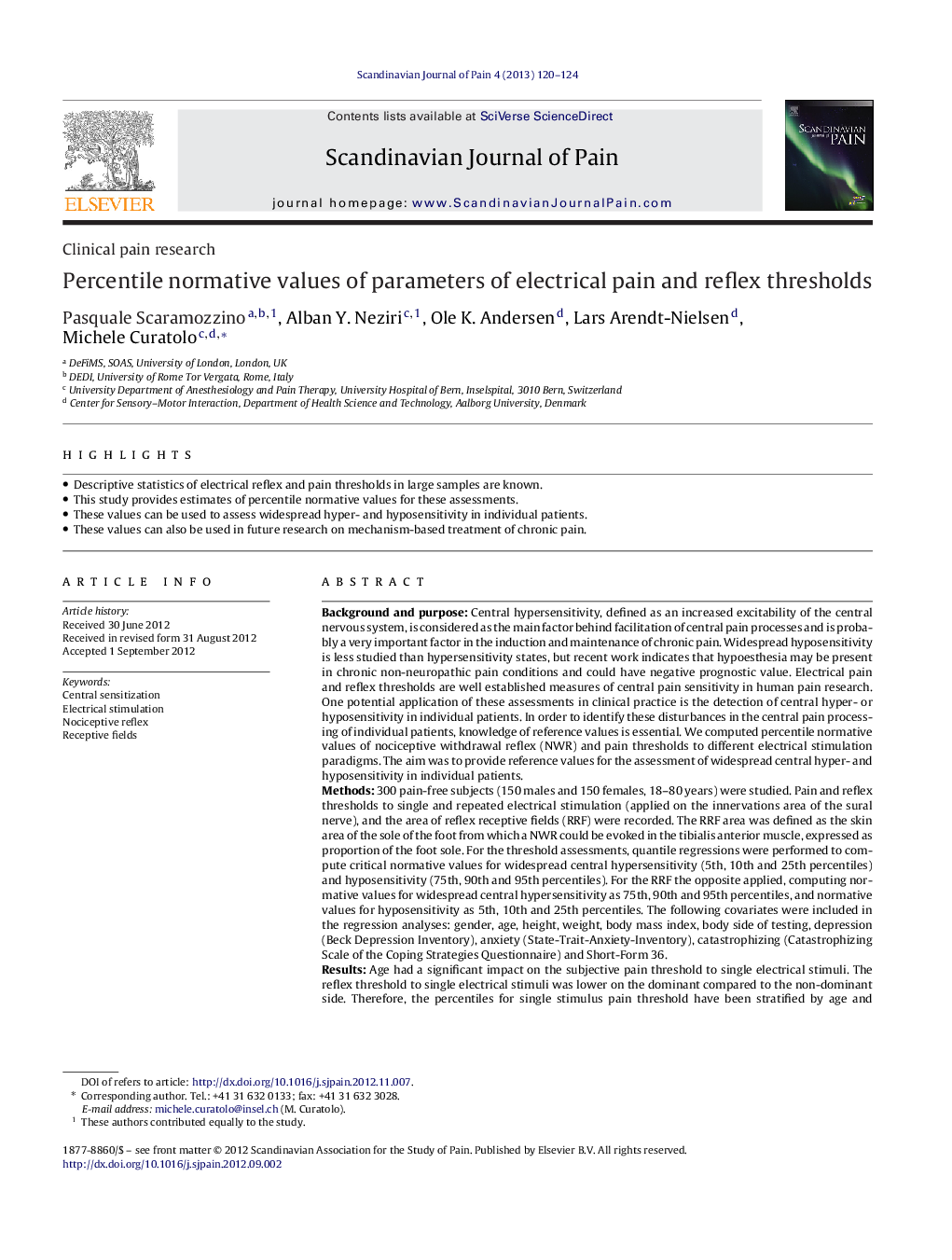| کد مقاله | کد نشریه | سال انتشار | مقاله انگلیسی | نسخه تمام متن |
|---|---|---|---|---|
| 2770750 | 1567821 | 2013 | 5 صفحه PDF | دانلود رایگان |

• Descriptive statistics of electrical reflex and pain thresholds in large samples are known.
• This study provides estimates of percentile normative values for these assessments.
• These values can be used to assess widespread hyper- and hyposensitivity in individual patients.
• These values can also be used in future research on mechanism-based treatment of chronic pain.
Background and purposeCentral hypersensitivity, defined as an increased excitability of the central nervous system, is considered as the main factor behind facilitation of central pain processes and is probably a very important factor in the induction and maintenance of chronic pain. Widespread hyposensitivity is less studied than hypersensitivity states, but recent work indicates that hypoesthesia may be present in chronic non-neuropathic pain conditions and could have negative prognostic value. Electrical pain and reflex thresholds are well established measures of central pain sensitivity in human pain research. One potential application of these assessments in clinical practice is the detection of central hyper- or hyposensitivity in individual patients. In order to identify these disturbances in the central pain processing of individual patients, knowledge of reference values is essential. We computed percentile normative values of nociceptive withdrawal reflex (NWR) and pain thresholds to different electrical stimulation paradigms. The aim was to provide reference values for the assessment of widespread central hyper- and hyposensitivity in individual patients.Methods300 pain-free subjects (150 males and 150 females, 18–80 years) were studied. Pain and reflex thresholds to single and repeated electrical stimulation (applied on the innervations area of the sural nerve), and the area of reflex receptive fields (RRF) were recorded. The RRF area was defined as the skin area of the sole of the foot from which a NWR could be evoked in the tibialis anterior muscle, expressed as proportion of the foot sole. For the threshold assessments, quantile regressions were performed to compute critical normative values for widespread central hypersensitivity (5th, 10th and 25th percentiles) and hyposensitivity (75th, 90th and 95th percentiles). For the RRF the opposite applied, computing normative values for widespread central hypersensitivity as 75th, 90th and 95th percentiles, and normative values for hyposensitivity as 5th, 10th and 25th percentiles. The following covariates were included in the regression analyses: gender, age, height, weight, body mass index, body side of testing, depression (Beck Depression Inventory), anxiety (State-Trait-Anxiety-Inventory), catastrophizing (Catastrophizing Scale of the Coping Strategies Questionnaire) and Short-Form 36.ResultsAge had a significant impact on the subjective pain threshold to single electrical stimuli. The reflex threshold to single electrical stimuli was lower on the dominant compared to the non-dominant side. Therefore, the percentiles for single stimulus pain threshold have been stratified by age and the percentiles for single stimulus reflex threshold by body side (dominant vs. non-dominant). Critical normative values of all tests were computed for widespread central hypersensitivity (5th, 10th and 25th percentiles) and hyposensitivity (75th, 90th and 95th percentiles). The values are provided in the table of the manuscript.Conclusions and implicationsThe computed estimates of critical normative values for the electrical pain test can be used in clinical practice for the assessment of widespread central hypersensitivity and hyposensitivity in individual patients, and in future research on mechanism-based treatment of chronic pain.
Journal: Scandinavian Journal of Pain - Volume 4, Issue 2, April 2013, Pages 120–124